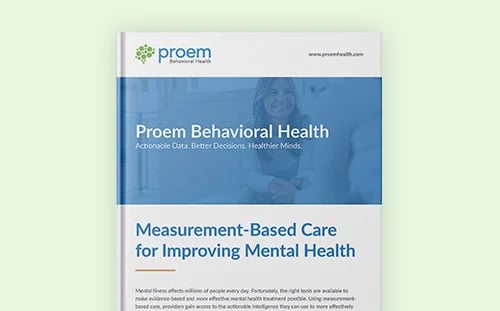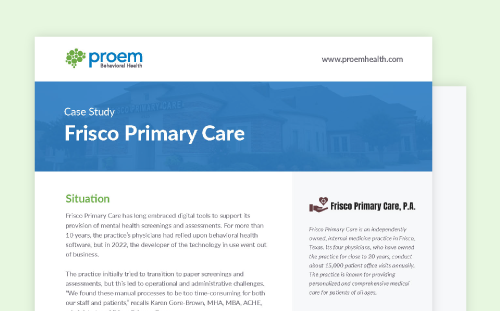
Substance use disorders (SUDs) have become increasingly common in the general population. According to the 2022 United States National Survey on Drug Use and Health (NSDUH), 16.7% of adolescents and adults 16.7% of adolescents and adults ages 12 and up qualified for diagnosis of a substance use disorder, and 10.5% of Americans 12 and older had an alcohol use disorder. And while overdose deaths fell in 2023 for the first time since 2018, there were still an estimated 107,543 drug overdose deaths in the United States according to the Centers for Disease Control and Prevention (CDC).
Healthcare providers can help to reduce these numbers and better support those with an SUD by implementing better screening and substance abuse assessment tools.
Substance Use Screening Tools in the Clinical Setting
Any patient can have concerning substance use habits, even if the person shows no apparent signs of addiction or has not mentioned substance-related concerns. That’s one of the reasons a SAMHSA consensus panel recommends that all primary care providers “periodically and routinely screen all patients for substance use disorders.” The panel notes that universal screening reduces potential racial, cultural, age and gender biases. Those biases are often unconscious and may drive a clinician’s decision to ask one person about substance use and not another.
Universal screening is a fair and unbiased first step in identifying an SUD. If a patient screens positive for risky or disordered substance use, the clinician can follow up with a more detailed assessment and recommend appropriate next steps with an SUD practitioner.
Evaluating Screening and Assessment Instruments
Screening and assessment protocol can only be effective if the practitioner has access to quality behavioral health tools. Before choosing an instrument for clinical use, decision-makers must determine whether it will be effective and appropriate for their patient populations. The wrong instrument may lead to misdiagnoses or false negative results.
SAMHSA and the American Psychological Association have provided guidance for clinical instrument evaluation across various populations. To evaluate screening and assessment tools, examine these key characteristics:
-
Sensitivity:
The instrument’s ability to identify people who have substance use problems. False positives are more likely with high-sensitivity tools. -
Specificity:
The ability to screen out people who do not have a targeted disorder. False negatives are more likely with high-specificity instruments. -
Test-retest reliability:
The likelihood of a test giving similar results after a brief interval, such as a few days to a week -
Classification accuracy:
The usefulness of scoring cutoffs in making accurate diagnoses -
Validity:
How well an instrument reflects the patient’s experience and behaviors -
Convergent validity:
Whether the instrument gives similar results compared to another instrument that measures the same problem -
Norm adequacy:
Whether the patient groups used to determine scoring metrics reflect the clinical population -
Fairness:
Whether test scores are clinically valid across populations
Reviewing norm accuracies and fairness helps SUD practitioners avoid choosing biased tools. If instrument developers developed test standards using a less diverse population, scoring might not be valid for all groups.
For example, SAMHSA’s Guide to Substance Abuse Services for Primary Care Clinicians states that “the CAGE test has been found to have a higher sensitivity for identifying alcohol dependence in African Americans compared to whites, while the AUDIT identifies alcohol dependence at roughly the same rate of sensitivity in both races.”
SUD practitioners should also evaluate instruments for organizational factors such as cost and ease of administration. Instruments that clinics can implement without disruption may have greater organization-wide adoption.
It’s also important to consider the likelihood of patient acceptance and resistance. Shorter screening questionnaires, when integrated into standard intake interviews, may encourage patients to disclose information that can help with discussions concerning substance abuse.
Common Drug and Alcohol Screening and Assessment Tools
There are a wide variety of substance abuse assessment tools to choose from; simply being informed of options is one step to improving patient outcomes. The National Institute on Drug Abuse (NIDA) lists common screening tools. A few of the most trusted and reliable tools that can and often should be used in SUD clinics and by providers working to identify an SUD are as follows:
- BARC-10 (Brief Assessment of Recovery Capital): This questionnaire measures an adult’s "recovery capital" to help predict the likelihood of an SUD patient staying in remission.
- HRSN (Health-Related Social Needs) screening tool: The HRSN asks adults questions about health-related social needs to determine the effect on total healthcare costs and better outcomes. It includes five core domains and eight supplemental domains.
- Urge to Use scale: As the name suggests, this scale measures the "urge to use" aspect of an SUD recovery. It asks adults six questions concerning a timeframe of the previous week.
- ACEs: Short for “Adverse Childhood Experiences,” the ACEs test delivers a score based on an adult’s childhood circumstances (e.g., childhood abuse, environment, and economic stability) that can impact the likelihood of behavioral health disorders, including SUDs.
- PEARLS: The “Pediatric ACEs and Related Life Events Screener” (PEARLS) for teenagers helps identify childhood experiences affecting a wide range of outcomes and risks, including the likelihood of an SUD.
Let's look at some other commonly used tools, some of which have downsides that you may want to consider before using them in your organization.
Alcohol Screening Tools
These screening tools identify alcohol use only and exclude other drugs. Common examples include:
- CAGE: A popular four-question screener that asks adult participants if they have ever tried to (C) cut down on their drinking, (A) annoyed loved ones by drinking, felt (G) guilty about drinking or needed an (E) “eye-opener” drink in the morning. Research has indicated that it has limitations in people with less severe alcohol-related problems, white women and college students, and it does not distinguish between current and past drinking problems.
- Alcohol Use Disorders Identification Test/AUDIT: A 10-item test for adults and adolescents developed to identify harmful or risky drinking. This tool is popular among providers but not based on diagnostic criteria.
Drug Screening Tools
Fewer screening tests target non-alcohol substances only. These may be useful for patients with an SUD diagnosis or those who completed an alcohol screening test during the same visit. Options include:
- Opioid Risk Tool–OUD: Screens adults for family and personal history of substance use and psychological illness, primarily to evaluate the appropriateness of opioid pain medications.
- Drug Abuse Screening Test/DAST: Originally a 28-item questionnaire, now commonly administered to adults and adolescents in its 10-question version. The DAST has separate adolescent and adult versions.
Substance Abuse Assessment Tools: PDFs and Websites for All-Substance Screening
Several instruments screen for alcohol and drugs inclusively. These tools make screening more convenient for clinicians and patients by reducing the number of forms involved. There are many such tools available, such as the following:
- Tobacco, Alcohol, Prescription Medication and Other Substance Use/TAPS: Screens adults for substance use and administers a brief assessment to individuals who screen positive.
- Screening to Brief Intervention/S2BI: Asks an adolescent patient about frequency of tobacco, alcohol and marijuana use, using the answers to sort the individual into a zero-, low- or high-risk category.
- Brief Screener for Alcohol, Tobacco and Other Drugs/BSTAD: Uses frequency-of-use questions to identify an adolescent’s risky behaviors for follow-up.
- CRAFFT 2.0: A six-item screener for adolescents that identifies risky substance use, including alcohol and drugs. It has earned praise for its validity across diverse populations. However, the National Center on Substance Abuse and Child Welfare has pointed out that CRAFFT 2.0 does not distinguish between risk and disorder.
- Personal Experience Screening Questionnaire (PESQ): A 40-item scale for adolescents that evaluates the severity of risky alcohol or drug use. It has earned popularity in community settings such as schools and medical clinics.
- Alcohol, Smoking and Substance Involvement Screening Test/ASSIST: An 8-item screener for adults and adolescents used to detect substance use issues in communities. The World Health Organization developed this screener for primary and general medical care use.
- UNCOPE: A six-question screener that asks about substance-related feelings and behaviors, such as preoccupation with substance use or neglecting responsibilities due to use.
Assessing Co-occurring Disorders in Clinical Settings With the M.I.N.I.
According to research published in the Journal of the American Medical Association, the rate of mood or anxiety disorders among people seeking substance use treatment ranges from 33% to 60%. Therefore, it is best practice for clinicians to screen for co-occurring disorders in all patients with suspected substance use disorder.
The Mini International Neuropsychiatric Interview (M.I.N.I.) and the M.I.N.I. Kid are highly validated screening tools that are particularly useful for identifying the most diagnosed mental disorders, including mood disorders. They can flag common co-occurring disorders when used in primary care settings and substance use disorder clinics.
For example, if an individual presents to an SUD clinic with a low mood, a substance use screening tool may attribute the person’s symptoms to substance use. Integrating a screener such as the M.I.N.I. will help alert clinicians to a mood or anxiety disorder and help the individual to receive the proper treatment.
Choosing and Administering Substance Use Screening and Assessment Tools
Clinics have numerous options for screening and assessment tools and formats in which these tools can be used. Clinics are increasingly migrating to tools available in digital formats because they allow for convenient administration, more accurate and efficient data capture and sharing, and increased consistency across an entire organization.
Proem is committed to making gold-standard screening tools accessible to SUD clinics and providers supporting those with an SUD or suspected substance use disorder. Offering a single platform tool that helps identify and support individuals with multiple and co-occurring disorders, Proem helps an SUD practitioner improve patient outcomes. The Proem solution is a user-friendly behavioral health engine that integrates behavioral health and substance use assessments into an organization’s existing workflow. Contact us today to learn how we can help your patients and organization.





.png)









